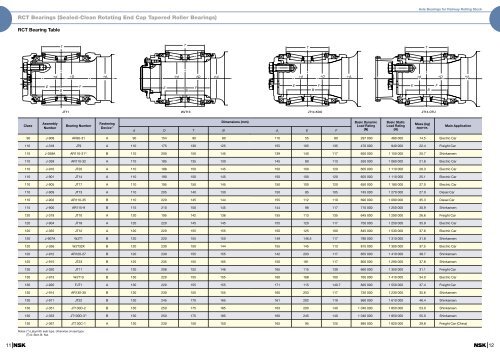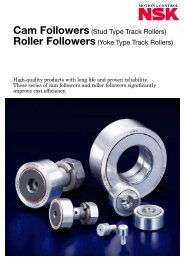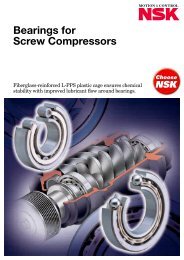Introduction to Axle Bearings for Railway Rolling Stock
Introduction to Axle Bearings for Railway Rolling Stock
Introduction to Axle Bearings for Railway Rolling Stock
You also want an ePaper? Increase the reach of your titles
YUMPU automatically turns print PDFs into web optimized ePapers that Google loves.
<strong>Introduction</strong> <strong>to</strong> <strong>Axle</strong> <strong>Bearings</strong> <strong>for</strong> <strong>Railway</strong> <strong>Rolling</strong> S<strong>to</strong>ck<br />
Characteristics of <strong>Axle</strong> <strong>Bearings</strong><br />
<strong>Rolling</strong> s<strong>to</strong>ck axle bearings are subject <strong>to</strong> radial impact<br />
loads caused by rail joints, switches and sometimes wheel<br />
flats, as well as <strong>to</strong> the static and dynamic radial loads of<br />
vehicle weight. They are also liable <strong>to</strong> receive axial loads<br />
generated by lateral movement as trains run on curved<br />
rails or in a snaking motion. All of these loads <strong>to</strong>gether<br />
<strong>for</strong>m complex combinations that act on axle bearings.<br />
<strong>Axle</strong> bearings must there<strong>for</strong>e be designed on the basis of<br />
not only dimensional requirements of the axle journal and<br />
bearing box geometry, but also these complex load<br />
conditions. Additionally, as axle bearings play a critical<br />
role in the safety of railroad operation, they are periodically<br />
disassembled <strong>for</strong> inspection. For this reason, simple and<br />
dependable procedures <strong>for</strong> disassembly, inspection and<br />
re-assembly are important design fac<strong>to</strong>rs as well. Utilizing<br />
its vast know-how and experience, NSK has designed,<br />
manufactured and supplied a wide variety of axle bearings.<br />
Types of <strong>Axle</strong> <strong>Bearings</strong> and Their Applications<br />
<strong>Axle</strong> bearings currently in use are classified in<strong>to</strong> the<br />
following six types based both on bearing type and<br />
sealing device:<br />
1. RCT <strong>Bearings</strong> (Sealed-Clean Rotating End Cap Tapered<br />
Roller <strong>Bearings</strong>)<br />
2. RCC <strong>Bearings</strong> (Sealed-Clean Rotating End Cap Cylindrical<br />
Roller <strong>Bearings</strong>)<br />
3. Spherical roller bearings<br />
4. Cylindrical roller bearings combined with ball bearings<br />
5. Cylindrical roller bearings with ribs<br />
6. Tapered roller bearings<br />
To ensure sufficient load-carrying capacity, all of these<br />
types are usually manufactured in double-row<br />
configurations.<br />
Globally, while plane bearings are still widely used, rolling<br />
bearings are increasingly being selected <strong>to</strong> replace them.<br />
All types of radial roller bearings, including tapered roller<br />
bearings, spherical roller bearings and cylindrical roller<br />
bearings, have been used in rolling s<strong>to</strong>ck axles based on<br />
the particular merits of each type.<br />
To improve operating efficiency, bearings must offer<br />
longer inspection intervals, simplified maintenance<br />
procedures and increased integration of bearing<br />
components and adjacent parts. To meet these needs,<br />
unitized bearings with advanced sealing devices have<br />
been introduced and are now widely used in modern<br />
rolling s<strong>to</strong>ck.<br />
7





